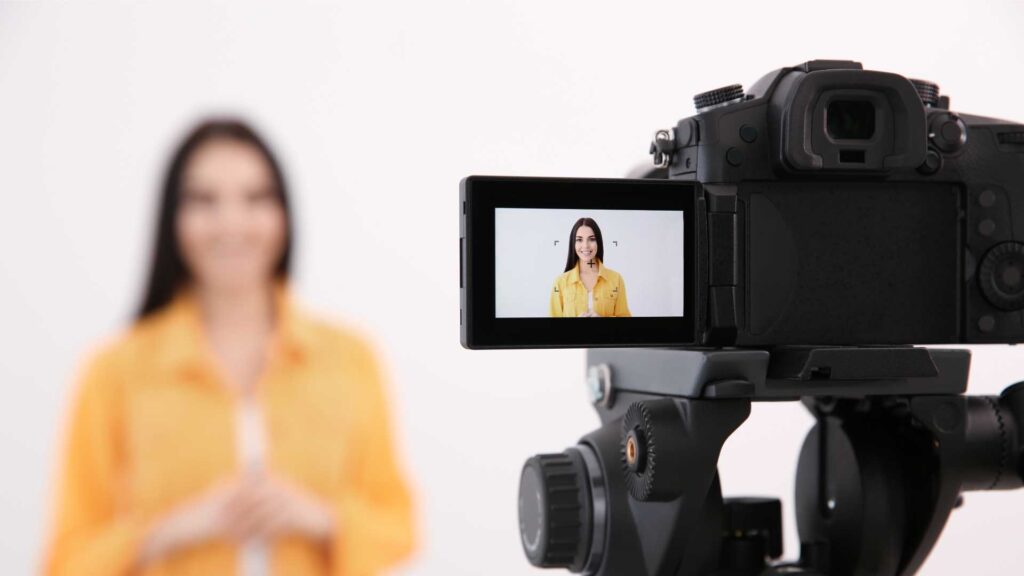Back
How to Have Confidence on Camera
Mastering comfort and confidence in front of the camera is within your reach! As you step onto that camera stage, excitement and a touch of nerves might be your companions. But don’t — here’s a bit of guidance to steer you in the right direction. Discover a handful of invaluable tips to ease your on-camera […]

Mastering comfort and confidence in front of the camera is within your reach! As you step onto that camera stage, excitement and a touch of nerves might be your companions. But don’t — here’s a bit of guidance to steer you in the right direction. Discover a handful of invaluable tips to ease your on-camera experience and help you shine.
Present Your Best Self on Camera
Variety in personal style is a treasure, but when it comes to the professional world, dressing the part is paramount. A little-known fact is that what appears pleasing on camera can differ from what your mirror reflects. Fear not, here are some gems to ensure your visual excellence.
- Opt for logo wear or business casual attire — always a prudent choice. Embrace long sleeves; generally, the camera captures your upper half. Yet, if there is a “set,” ensure your attire is suitable for a full-body shot. Bid adieu to shorts and unkempt sneakers.
- Reserve the overly vibrant shades for another day; instead, favor subtle hues and jewel tones. Sidestep blinding white. When it comes to enhancing skin tone enhancement, choose something blue.
- Navigate away from intricate patterns or pinstripes; simplicity in solid colors reigns supreme.
- Keep jewelry modest. Abundant bracelets and imposing necklaces might meddle with pristine audio. While statement pieces have their moment, remember they might age with time; so keep to timeless and uncomplicated elegance.
Dressing for success comes with a bonus — aligning your style just slightly above or in sync with your audience’s taste can significantly enhance your on-camera comfort. You don’t want to be over-dressed or appear overly casual. Get it right and you are sure to grace the screen confidently.
Nonverbal Communication
There is a lot to consider in regard to what your body is saying, especially your face when you are on camera. Think about the following regarding nonverbal communication as you step in front of the camera.
Decoding Your Facial Language
Often, individuals are unaware of the vibes they radiate. With the camera’s lens capturing the minutest details, your facial expressions hold a special significance. The fervor and zeal for your subject matter should shine through, unfiltered. Strive for an authentic blend of naturalness, warmth, and professionalism- that is the key. Uncertain about your visual narrative?
A great trick is to rehearse in the mirror. I know what you are thinking. It feels weird to watch yourself. Trust me will be able to see if your face is in harmony with the content’s essence. Deviation runs the risk of conveying contradictory signals- that is a surefire way to sow doubt among your audience about the true essence of your message.
On-camera communication on another facet- eye contact. During interviews, your gaze should naturally meet the eyes of the interviewer. If you find yourself comfortable with the camera lens responsible for your close-up, occasionally look at it. This can foster a connection with your audience. However, tread carefully – the slippery slope of unintentionally gazing astray is real.
Body Language
The language your body speaks is as profound as your words. Prioritize maintaining an impeccable posture and please avoid slouching. This is true in person, but it is even more important when you’re facing the camera.
A common misconception is the notion that you should not use your hands. Nothing could be further from the truth. In reality, your hands can serve as allies in easing your composure. However, like every art, it takes finesse. Gesture within the vicinity of your midsection. Refrain from getting your hands too close to your face – that can be disruptive when captured on camera. Remember, repetition has its pitfalls; overuse of gestures, such as excessive pointing, can foster discomfort. Aim for gestures that have a relaxed and affable demeanor.
Voice & Tempo
Your voice is unique. However, you hold the reins over certain aspects. Pitch, while resistant to drastic alterations, can be fine-tuned. Want to know how you sound to others? Use a smartphone or a recording gadget, utter a few lines, then listen closely. If a touch of squeakiness creeps in, recall the power of deep breaths. Should your tone take on a muddied quality, articulate and use a measured cadence. That ensures saying the words clearly.
In the realm of nerves, speedy delivery is a clear indicator of your discomfort. This trend deserves your scrutiny. When your content is intricate, your pace must be slower for the viewer to absorb the concepts. And use the pause. It is a powerful tool that is often overlooked.
Finally, let’s look at vocal expression. A monotonous voice lacks vitality, there is no thrill. Think of reading a fairy tale to a young listener. Expressiveness casts emotion into words, accompanied by pitch shifts and rhythmic variations.
A parting whisper: A booming voice is unnecessary; the audio level rests in the hands of the professionals. So be yourself and the professional will make you sound amazing in post-production.
One Last Piece of Advice
While it is important to have talking points ready for your on-camera experience, do not memorize answers or have a script ahead of time. Doing so can make you seem unnatural and can be off-putting to viewers. And remember, cameras may be rolling at any time-so be careful what you say!
Need media training?
If you’re nervous about an upcoming camera appearance, contact Cynthia Kay. She can help with media training to help you feel comfortable and confident in front of the camera.
